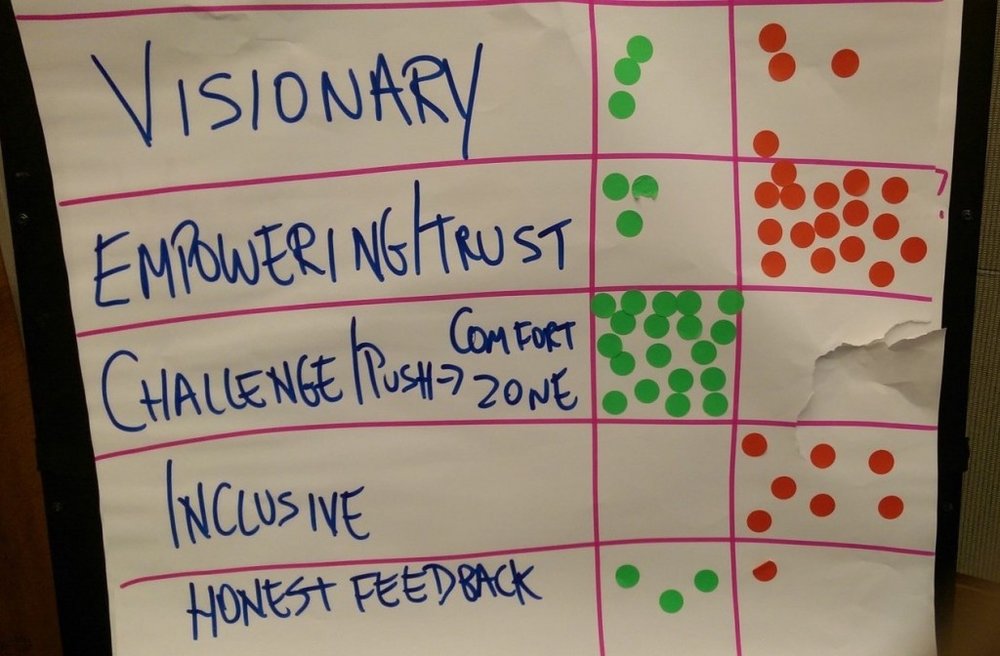Every leader (and organization) has its strengths.
Where do the strengths serve well?
Where do they incur costs?
I led the following awareness-building exercise with a team of leaders at a manufacturing organization. You can try it with alone, or with your team.
Leadership Quality Awareness Exercise
-
Think back on all the leaders you’ve ever worked with in your life. Make a list of the most important qualities leaders the best leaders demonstrated to create a successful environment.
-
Narrow your list down to the top five qualities.
-
Write up these five on a flip-chart/whiteboard.
-
Of these five, which one quality does your current organization (or team) do best? Put a green dot in the next column. (Each person gets one green dot/one vote.)
-
Which one quality does your organization (or team) have most room to improve? Put a red dot in that column. (Each person gets one red dot/one vote.)
-
Debrief and discuss the results.

climates leaders dots
Here’s what this team’s results looked like:
As you can imagine, seeing these results led to a rich conversation.What really popped out for the group were the categories with the top red dot (“challenge/push people out of their comfort zone”) and green dot (“empowering/trust”) votes.
They felt these two qualities were deeply interconnected, and quickly jumped to giving examples of how these qualities are seen every day at work.”
Challenge/push beyond comfort zone” shows up in the intense focus on personal accountability. Setting annual, semi-annual, and monthly goals (with frequent checks) is baked into their company culture, along with the belief that if the organization didn’t push this hard, it wouldn’t succeed.
In regards to “Empowerment/Trust”, the group identified that mid-level and senior leaders don’t operate with much free rein. For example, many current policies (HR, Finance, IT, etc.) mandate getting multiple layers of approval before being able to move decisions forward. These policies slow things down, and the lack of autonomy is demotivating.
This combination creates a culture where the leaders feel they have accountability, but without authority. As one person remarked,
Maybe that’s why “inclusive” got no green dots.
The group’s experience with the awareness exercise is not unusual. Many organizations have a culture where “challenge/push past comfort zone” is their strength, but rank low on “empowerment/trust”.
There’s nothing inherently wrong with “challenge/push past comfort zone”. It’s a basic human virtue: the one that underpins having a strong drive to achieve. It’s what fuels top performers to move beyond what’s comfortable, and work towards their dreams. It’s the virtue that we admire in others; it’s what inspires the rest of us to tune in and watch athletes compete at the Olympic Games.
However, as Aristotle described over 2000 years ago, in his philosophy of the Golden Mean, any quality (or virtue) taken to excess without a balancing opposite can lead to problems. For example, the athletes who train to excess end up injured and can’t compete at all.In an organization, a balancing opposite of “challenge/push beyond comfort zone” is “empowerment and trust”.Consider this: If you have a high-performance vehicle (drive to achieve) and want to drive it in a specific direction, wouldn’t you want to make sure it travels over a solid and smooth road (empowerment and trust)?
Without the smooth road of trust, the road is bumpy and the ride is more difficult.What does that “bumpy road” in a company feel like?
Compliance without commitment. People say yes on the outside, but have no desire to do any more than is necessary. There’s no real willingness to bring things to the surface. This leads to the all-too-common “meetings after the meetings”. In a compliance without commitment company, you might often hear the phrase “Well, it is what it is.” It’s this kind of compliance that leads to disengagement.
Fear-based (me first) behaviors. With trust absent, people don’t know if any actions they take for the larger whole will be reciprocated. Thus, (out of self-preservation) they put their own needs ahead of the needs of any greater good. They are afraid of losing what they have, or afraid of not getting what they need. It’s from this place of fear that cliques, alliances and silos form.
Slow or non existent information sharing. Low trust means low speed. Information stagnates when people are operating from fear. Rather than thinking proactively, strategically and long-term, fear induces reactive, tactical and short term thinking. People are busy, but not necessarily busy doing the right things. Agility evaporates. Collaboration diminishes.
The Leadership Quality exercise is designed to raise awareness. It’s a quick diagnostic to take a snapshot of what your team is thinking and feeling in this moment in time.
The good news: the results are not permanent. You (and your organization) can change. Ask the team: What would it take to make the red dots green? What would we have do differently?
People and companies are complex. There’s not a “one strength fits all” magic solution – and there doesn’t have to be. Using the principle of balancing opposites, you have the ability to cultivate multiple qualities that will serve you and your organization for both the short and long term.
How else have you seen a “Drive To Achieve” mentality cost an organization? Join the discussion by leaving a comment below.
